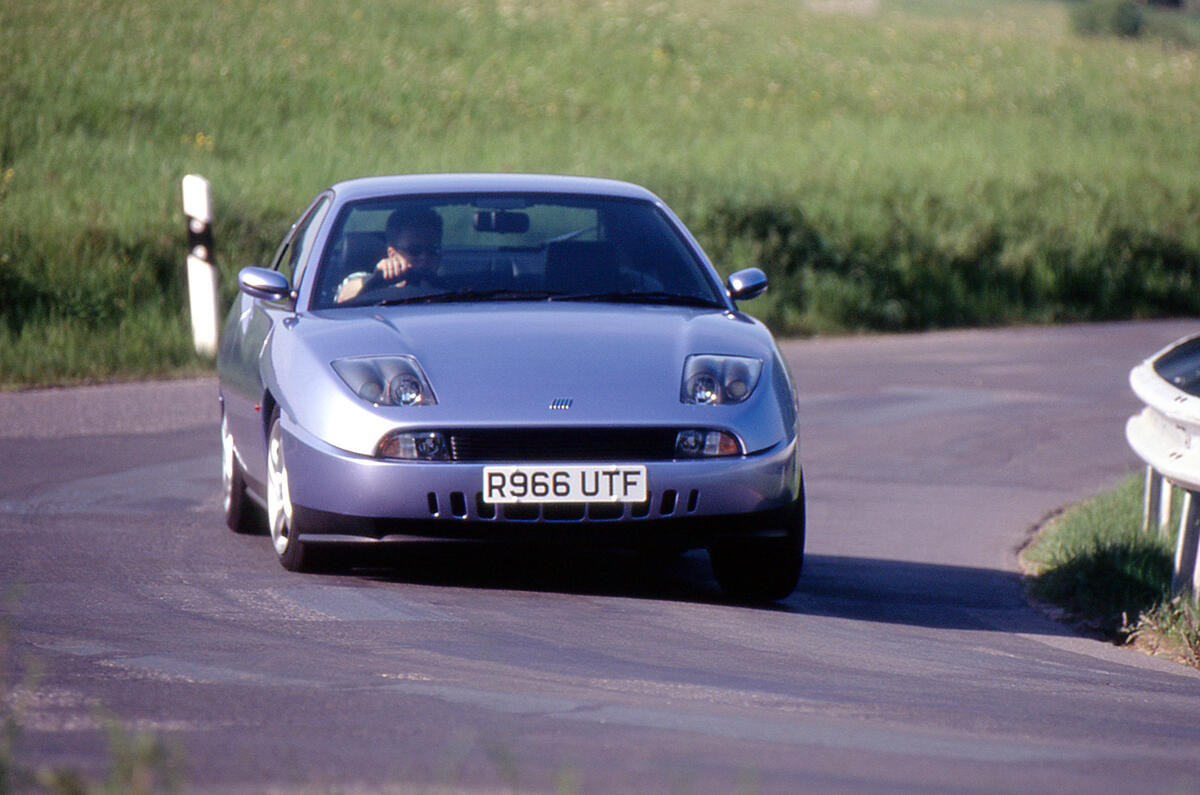Proportions more arresting than elegant. Superfluous, slash-like indentations above the wheel housings.
Double-blistered headlamp covers, deep-recessed taillights, an aluminium flip-top fuel filler, an aluminium key-fob and a bold repeat of the car’s exterior colour arcing across the dashboard.
This was the Fiat Coupé, a car unexpectedly signaling that its maker was ready to build sports cars again, and a car signaling the arrival of one Chris Bangle, a designer who would soon stir up the car industry like few designers before him.
This car was a surprise not just for its shape, but because Fiat had previously said that it would no longer make pure sports cars, despite a glorious run in the 1960s that included the pretty 850 Coupé and Spider, the 124 Spider, the 124 and 128 Coupés, the Dino Coupé and the exquisite Fiat Dino Spider.
That was before Paolo Cantarella arrived to take charge of Fiat Auto in 1989.
Cantarella was a businessman who had previously managed the Fiat Group’s industrial robot division Comau, but he was also a car enthusiast, and acutely aware of the Italian car industry’s past successes
Like any CEO, his overriding mission was to keep the Fiat Auto motor running sweetly, and while Puntos and Pandas sold by the trainload, the bigger Tipos and Cromas were more of a struggle.
The Fiat brand needed some burnishing and, if the numbers could be made to work, this new coupé could help.
Work began around 1991 at both Fiat Centro Stile and Pininfarina, the pair producing quite different proposals.
Pininfarina’s was crisp, subtle, well-proportioned, elegant and conventional.
Fiat’s in-house suggestion bordered on the outlandish, its wheel arches capped with angled elliptical blisters in black, a crease bisecting the upper third of its doors at exactly the same angle. Its tail was short, its boot lid no more than a modest capping.
It wasn’t beautiful but it was daring, original and fresh. Fiat bravely went with this proposal rather than Pininfarina’s, and while the finished article grew a longer and appealingly pert tail, the spirit of Bangle’s startling design survived largely intact.
Pininfarina’s interior suggestion featuring a swathe of body colour paneling across dashboard and doors easily won the interior competition, the coachbuilder also winning the manufacturing contract.
The business case was strengthened by using a cut-down Tipo hatchback platform, engines from the Lancia Delta Integrale and plenty of shared parts.
Few of these were visible, however, the Fiat was as memorable for the bespoke detail in its design as for its highly individual look. And there were more than the slashes and the fuel cap to savour.
The bonnet was a huge clamshell pressing that rose skywards complete with grille and headlights. The headlights themselves were odd enough to have been questioned during Fiat’s internal design reviews, one manager asking how they might be cleaned with headlight washers, given their contours and near-horizontal mounting.
‘Con amore,’ came the smiling reply, an answer that closed the conversation down.
Front-wheel drive and Tipo-based the Coupé may have been, but it rolled on a well-sorted chassis propelled by rorty, sporting engines, the potent turbo version featuring a viscous coupling limited-slip differential that did a great job of firing torque to Tarmac.
The 16V turbo was quick, the 217bhp five-cylinder turbo rabidly so, scoring 6.5sec sprints to 62mph and 155mph. This Fiat was more about outright grip than throttle-adjustable handling finesse, making for slightly less-than-stellar entertainment, but as a total package, complete with four usable seats and a fair boot, it worked.
Fiat launched its coupé with the memorable claim that, ‘In Italy, no-one grows up wanting to be a train driver’, together with a fine picture of the machine in broom yellow. Ironically, Fiat owned the company that made the rapid Pendolino high-speed train at the time, but no-one cared about that – this Fiat was exciting.
Prices are edging up, but somehow this Fiat doesn’t yet feel a complete classic despite its credentials, and despite some bold pricing from optimistic vendors.
This column first appeared as an email to subscribers.




Join the debate
Add your comment
A rare example of the production model looking better than the concept. Still a great looking thing.